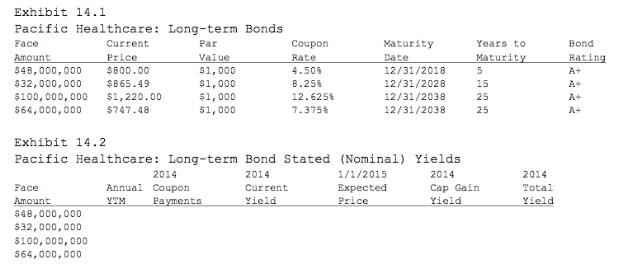Question
Pacific Healthcare is an investor-owned hospital chain that owns and operates nine hospitals in Washington, Oregon, and northern California. Marcia Long, a recent graduate of
Pacific Healthcare is an investor-owned hospital chain that owns and operates nine hospitals in Washington, Oregon, and northern California. Marcia Long, a recent graduate of a prominent health administration program, has just been hired by Washington Medical Center, Pacific's largest hospital. Like all new management personnel, Marcia must undergo three months of intensive indoctrination at the system level before joining the hospital. Marcia began her indoctrination in January 2014. Her first assignment at Pacific was to review its latest annual report. This was a stroke of luck for Marcia because her father owned several bonds issued by Pacific, and Marcia was especially interested in whether or not her father had made a good investment. To glean more information about the bonds, Marcia examined Note E to Pacific's consolidated financial statements, which lists the company's long-term debt obligations, including its first mortgage bonds, installment contracts, and term loans. Table 14.1 contains information on four of the first mortgage bonds listed in Pacific's annual report. All four bonds pay interest semi-annually. Pacific's chief financial officer, Hugo Welsh, found out about Marcia's interest in the firm's debt financing. Because you are so interested in our financial structure, he said, I want you to do the bond valuation and make a presentation to our executive committee. Hugo then asked Marcia to perform the calculations required to complete Exhibit 14.2 and to think about some of the questions that members of the committee might ask her about the numbers.

Questions:
- To prepare for the meeting, create a summary of the yields of each bond by completing the table shown in Exhibit 14.2. Remember that the YTM of each bond is assumed to be the required rate of return of each bond and that the semiannual YTM must be multiplied by two to get the stated (nominal) YTM.
- At the meeting, a committee member asks, “The two 25-year bonds have the same maturity date, so why do the current yields and capital gain yields of these bonds differ?” What do you reply to the committee member? (Hint: No additional calculations are required.)
- The committee chair states that it is important for Pacific to understand the market for its debt. “I understand that Pacific's bonds are held primarily by tax-paying investors, so I want to know whether they prefer one of the 25-year bonds over the other and why.” (Hint: No additional calculations are required.)
- The committee chair states that interest rates change over time which causes interest rate risk. She asks you to identify the bond that has the most price risk. (Hint: For each bond, compare the values at interest rates of 6, 8, 10, 12, and 14 percent.)
- The chair then asks you to identify the bond that has the greatest reinvestment rate risk for an investor who has an investment horizon (or expected holding period) of 25 years. Is there a type of bond the investor could buy to eliminate reinvestment rate risk? (Hint: No additional calculations are required.)
- A committee member suspects that some of Pacific's bond holders are short-term speculators as opposed to long-term investors. He believes that interest rates are going to fall from current levels and asks you which Pacific bond would speculators buy to maximize short-term capital gains and why. (Hint: No additional calculations are required.)
- The Chair comments that the 15-year and both 25-year bonds are callable five years from today at $1,050 and asks you for the yield-to-call on each of the three bonds.
- Finally, the Chair states that most bond market analysts believe that interest rates will remain at the 10 percent level for the next several years. She asks you whether Pacific should consider calling any of its bonds and why. (Hint: No additional calculations are required.)
Exhibit 14.1 Pacific Healthcare: Long-term Bonds Par Face Amount Current Price $48,000,000 $800.00 $32,000,000 $865.49 $100,000,000 $1,220.00 $64,000,000 $747.485 Face Amount $48,000,000 $32,000,000 $100,000,000 $64,000,000 Value $1,000 $1,000 $1,000 $1,000 Exhibit 14.2 Pacific Healthcare: Long-term Bond Stated (Nominal) Yields 2014 Current Yield Annual YTM Coupon Rate 4.50% 8.25% 12.625% 7.375% 2014 Coupon Payments Maturity Date 12/31/2018 12/31/2028 12/31/2038 12/31/2038 1/1/2015 Expected Price Years to Maturity 5 15 25 25 2014 Cap Gain Yield 2014 Total Yield Bond Rating A+ A+ A+ A+
Step by Step Solution
3.44 Rating (167 Votes )
There are 3 Steps involved in it
Step: 1

Get Instant Access to Expert-Tailored Solutions
See step-by-step solutions with expert insights and AI powered tools for academic success
Step: 2

Step: 3

Ace Your Homework with AI
Get the answers you need in no time with our AI-driven, step-by-step assistance
Get Started


